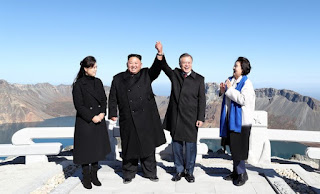National Assembly by-elections background
There are going to be 12 by-elections for the National
Assembly on June 13th. As no party currently has a majority in the National Assembly these elections could be crucial in deciding close votes over the next few years.
I’m going to try and do a blog on all 12 of the elections. In the meantime a list of the elections can be found on wikipedia. but first thought I’d do an introduction of a) how National Assembly elections work b) how the last election in 2016 went and c) what has gone on in terms of party politics in the national assembly since then.
I’m going to try and do a blog on all 12 of the elections. In the meantime a list of the elections can be found on wikipedia. but first thought I’d do an introduction of a) how National Assembly elections work b) how the last election in 2016 went and c) what has gone on in terms of party politics in the national assembly since then.
Korean general elections use two different electoral systems
and every voter gets two votes. Voters are given a ballot for their
constituency/ district- 253 members are elected by first past the post in
single member constituencies. Voters are also given a ballot with political
parties on it. 47 members are elected from these ballots by proportional
representation.
2016 election results:
Democratic 123
New Frontier 122
People’s Party 38
Justice Party 6
Independents 11
Current party political makeup
Democratic 118
Liberty Korea 113
Righteous Future Party 30
Peace and Justice Party 20
Minjung 1
Korean Patriots 1
Independents 5
Vacant 12
Clearly quite a lot has happened since the elections in 2016
I’ll start with the Democratic Party. 2 members have
defected other parties. 3 of their seats are now vacant. The President of South
Korea is now Moon Jae-in, the leader of the Democratic party. That was easy.
The New Frontier party has rebranded after the impeachment
and imprisonment of their President Park Geun-hye. They are now known as the
Liberty Korea party and are down to 113 members. In 2016 the breakaway Righteous
Party formed to try and force Park from office. Most of these members
have since returned. One member left to the pro Park Korean Patriots
party after her impeachment.
4 of their seats are now vacant
The People’s party was only founded as a breakaway from the
Democratic party in 2015. The People’s Party never really made their mind up
where they were on the political spectrum initially claiming to be a new radical centrist party then running (at least rhetorically) to
the left of the Democrats in the 2016 National Assembly elections. Then in 2017
their candidate Ahn ran in his presidential campaign as a centrist- spotting a
gap in the market when the relatively left-wing Moon Jae-In won the Democratic
primary and the hard-right Hong Jun-Pyo won the Liberty Korea parties
nomination. Therefore, the People’s Party had members from different parts of
the political spectrum. After Ahn came third in the Presidential election the
party had quite a lot of infighting. In January 2018 Ahn pushed through a
merger with the remnants of the Righteous Party to form the new centrist
Righteous Future party. However 14 more left-wing members rejected this attempt
and formed the Party for Democracy and Peace. In the assembly having a group of
20 members is important bringing numerous benefits including state subsidies. So
they formed a parliamentary coalition with the left wing Justice Party though
outside of parliament they remain two separate parties.
4 seats initially won by the People’s Party are now vacant.
The Minjung Party (I’ve stuck with the Korean name because
it also translate’s to People’s Party and I didn’t want anymore confusion than necessary!)
seems to be a re-foundation of the United Progressive Party which was outlawed
by the Supreme Court for its alleged ties to North Korea. In 2017 they
attracted two left wing independents from the Ulsan area though one of there
members has been removed from the assembly for breaking campaign finance laws.
Follow me on twitter: https://twitter.com/michaelhill94/
Follow me on twitter: https://twitter.com/michaelhill94/


Comments
Post a Comment